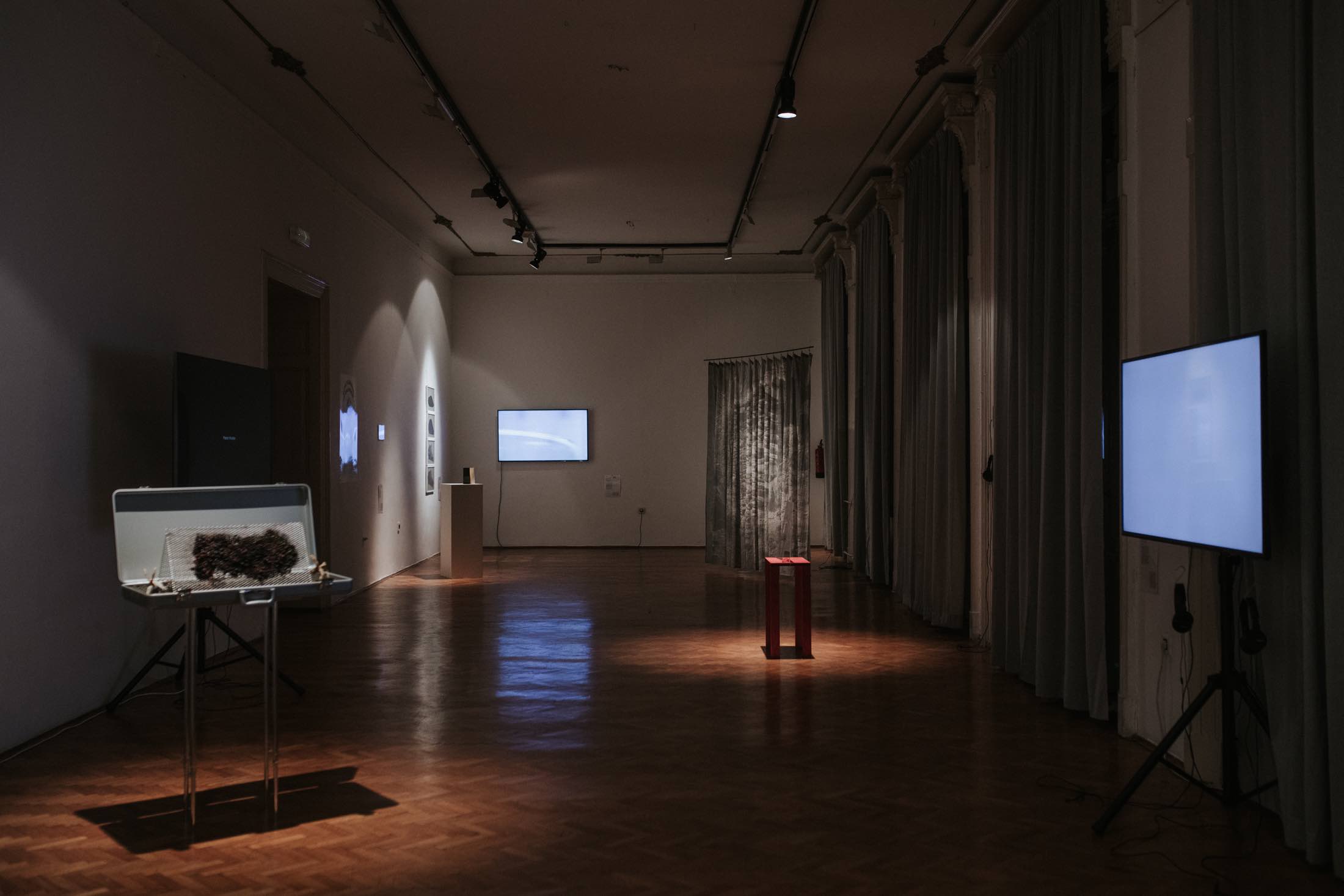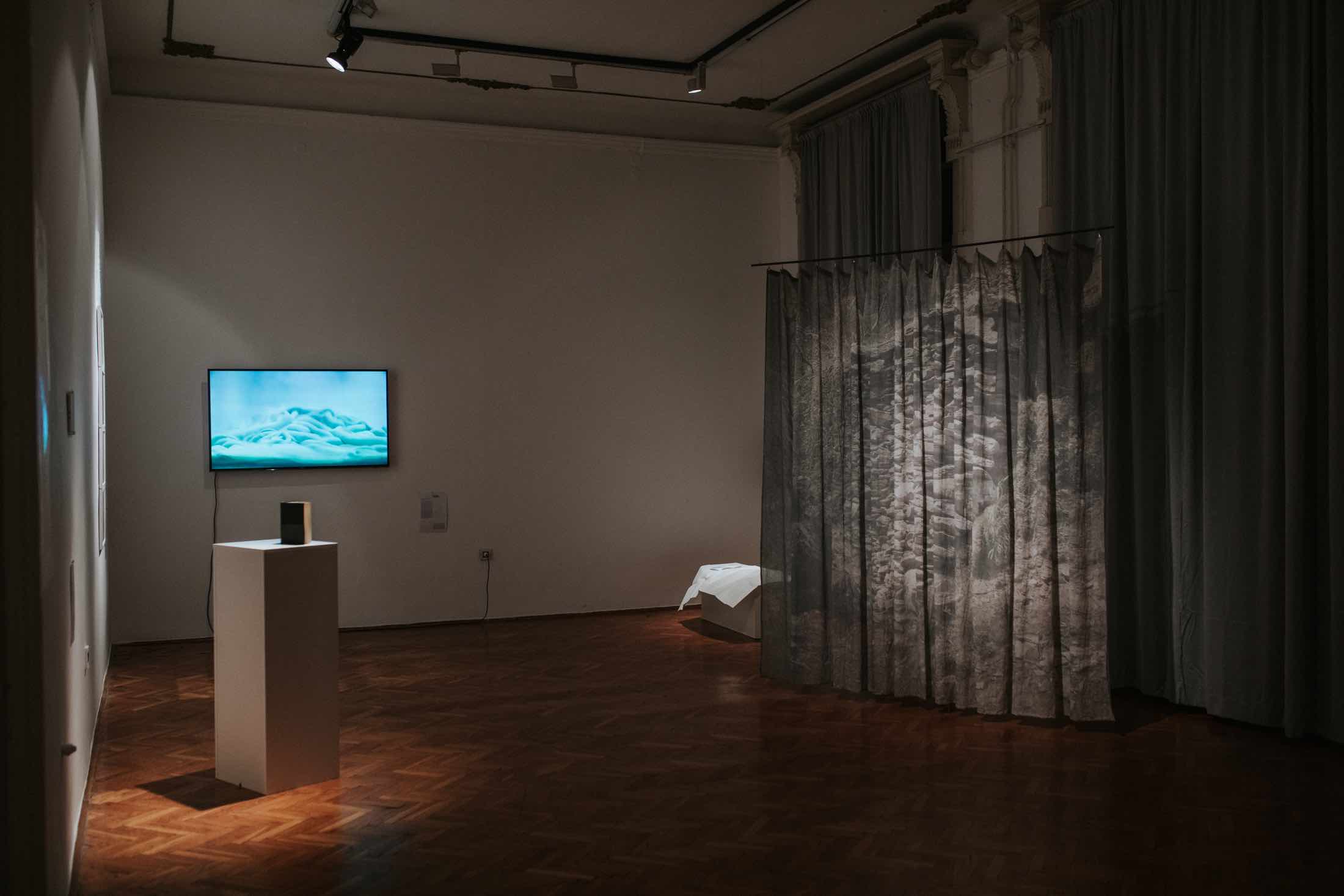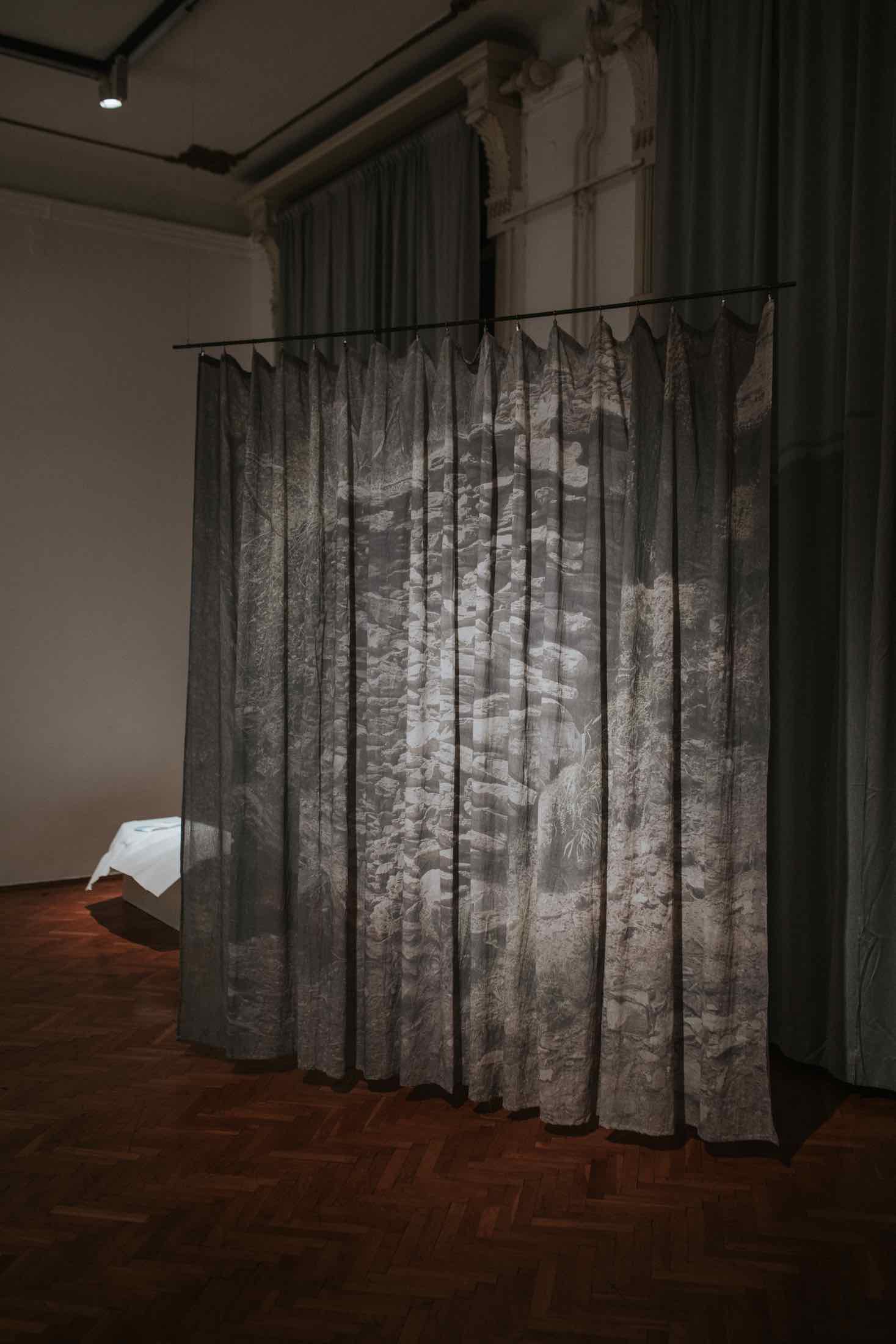


An attempt to build a dry stone wall / ein versuch eine mauer zu bauen Exhibition view Digital print on organic fiber, curtain rail, wood approx. 360 x 220 cm 2020 *
An attempt to build a dry stone wall refers to the contrast between the image represented and the material on which the image appears. The weight of a stone wall is set in a thin, almost transparent material, linking to forms of representation as carriers of apparent histories. An old stone wall that gives insight into the site’s history appears also as an overgrown part of a present landscape. The technique of dry masonry does not require any addition of material besides what is found on site. The wall appears as a cartographic gesture as well as an architectural structure that enables agriculture in steep geography. By literally rebuilding on the ruins of a decayed wall, where nature-culture intersections get blurred, the work refers to the archaeological memory of the river valley as a site of co-existence, dependency, and control.
Mapping the Cartographic: Contemporary Approaches to Planetarization
Group-exhibition curated by Collective Rewilding (Sara Garzón, Ameli M. Klein, Sabina Oroshi), assisted by Lauren Fuller,
at Drugo More and Online, Rjieka, Croatia
20.01.–18.02.2022, Online 04.02.2022
After Earth’s famous Apollo 17 photograph “The Blue Marble” of 1972, contemporary art has engaged in a view of the planet, where Earth, as WTJ Mitchell explains, has been treated as an image. This is so much so that to enter a space today is like entering a virtual picture, where the subject is only but a character in a preconceived image or stage. In that regard, the exhibition, Mapping the Cartographic: Contemporary Approaches to Planetarization, inquiries into practices that counter the sense of the “real,” which defined by algorithmic images and other visualization technologies add to the extensive repertoire of representations of the natural world.
Since it is through media that we grasp the Earth’s multiple manifestations we must acknowledge the important relationships embodied in map-making practices. Media theorist Jussi Parikka explained that “our relationship with the Earth is mediated through technologies and techniques of visualization, signification, calculation, mapping, prediction, simulation, and so forth.” “It is through and in media,” says Parikka that “we grasp Earth as an object for cognitive, practical, and affective relations.” Maps, however, have been continuously acknowledged as neutral or universal, for these visual and often hyperreal technologies underscore a sense of the “natural” that support dominant ideas about nature as being external to humans.
The selected artworks, therefore, use the provocation of mapping as a strategy to navigate what Amy J. Elias and Christian Moraru called the complex “understanding of virtual and physical spatiality that constitutes the lived circumstance of interrelatedness.” In proposing other approaches to cartography, the artworks underscore the necessity of deconstructing linearity and one-point perspective, offering instead spaces of re-territorialization, new temporalities, and recognition of all human and non-human actors that make all forms of spatialization possible. In that regard, the exhibition asks: How can artistic projects undermine or rethink the technification of the natural and its rendition as real? How is digital representation mediating our changing notion of the “natural” as a boundary, resource, or engendered terrain?
The concept of planetarization further underlines the importance of critically thinking about the mediums, perspectives, and visual forms that contemporary artists are using to emphasize the urgent need for new orientations towards the world. The view of planetarization that these artworks embody, ultimately reveal what Bruno Latour stressed: that we can no longer treat the Earth as the backdrop of our reality but as a co-producer through which agencies are redistributed. The return to an earth-based thinking as alluded to by the concept of planetarization is, thus, a call to radically open the possibility of what constitutes nature, space, and reality. This is a strive towards new and alternative meanings beyond those stipulated by western (modern) visuality, which although has resulted in a variety of “cartographic impulses,” demonstrates a collective process, a geopolitical vision, and a poetic notation that captures our disappearing landscapes. Ones that despite constant monumentalization have remained imperceptible to the human eye, or at least until now when we finally begin to grasp the full significance of its demise.
The show includes artworks by: Iman Datoo (UK), Aksiniya Peycheva (Bulgaria), Pedro Hurpia (Brazil), Marina Camargo (Brazil), Marina Fraga (Brazil), Monika Gabriela Dorniak (Germany), Hara Shin (Germany), Paula König (Germany), Hanne van Dyck (Belgium), Yiannis Pappas (Greek), Matheus da Rocha Montenari (Brazil), Deborah Mora (Italy), Latent Community (Sotiris Tsiganos and Ionian Bisai), and Luka Kedžo (Croatia).
Collective Rewilding is a curatorial group and research laboratory that proposes critical new examinations and optical perspectives to help unpack histories of resistance, knowledge exchange, and networks of artistic solidarity against colonial and Anthropocenic structures of power. By problematizing the concept of rewilding, we investigate the intersections of care, ecology, and curatorial practice. Rewilding, in that sense, constitutes a methodology for curatorial and artistic practice that helps us situate ourselves vis-à-vis each other, other-than-human beings, and our multiple yet disparate emergent social concerns. Aiming to construct assemblages of views, temporalities, and peoples, we engage in practices that depart from a multi-species, feminist, and decolonial ontology.
texts here by collective rewilding, more information can be found here. all photos by Tanja Kanazir, thank you
*
Watch the Artist Talk “PLANETARY CARTOGRAPHIES” ! The collective Latent Community, the artists Marina Camargo and Paula König are in conversation with Sara from Collective Rewilding about their participation in “Mapping the Cartographic: Contemporary Approaches to Planetarization”.